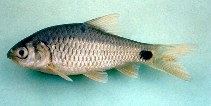Upload your photos and videos
Pictures | Google imageBarbodes binotatus
Picture by Baird, I.G.
Pictures | Google imageBarbodes binotatus
Picture by Baird, I.G.
Indonesia country information
Common names:
Bada putiah, Bilak, Bunter
Occurrence: native
Salinity: freshwater
Abundance: | Ref:
Importance: commercial | Ref:
Aquaculture: | Ref:
Regulations: | Ref:
Uses: no uses
Comments: Known from Java, Bali, Sumatra and Borneo (Ref. 36654). Also Ref. 26580, 36949.
National Checklist:
Country Information: https://www.cia.gov/library/publications/resources/the-world-factbook/geos/id.html
National Fisheries Authority:
Occurrences: Occurrences Point map
Main Ref: Kottelat, M., A.J. Whitten, S.N. Kartikasari and S. Wirjoatmodjo, 1993
National Database:
Occurrence: native
Salinity: freshwater
Abundance: | Ref:
Importance: commercial | Ref:
Aquaculture: | Ref:
Regulations: | Ref:
Uses: no uses
Comments: Known from Java, Bali, Sumatra and Borneo (Ref. 36654). Also Ref. 26580, 36949.
National Checklist:
Country Information: https://www.cia.gov/library/publications/resources/the-world-factbook/geos/id.html
National Fisheries Authority:
Occurrences: Occurrences Point map
Main Ref: Kottelat, M., A.J. Whitten, S.N. Kartikasari and S. Wirjoatmodjo, 1993
National Database:
Common names from other countries
Classification / Names Common names | Synonyms | Catalog of Fishes(genus, species) | ITIS | CoL | WoRMS | Cloffa
Teleostei (teleosts) > Cypriniformes (Carps) > Cyprinidae (Minnows or carps) > Smiliogastrinae
Etymology: Barbodes: Latin, barbus = barbel + Greek, oides = similar to (Ref. 45335).
More on author: Valenciennes.
Etymology: Barbodes: Latin, barbus = barbel + Greek, oides = similar to (Ref. 45335).
More on author: Valenciennes.
Environment: milieu / climate zone / depth range / distribution range Ecology
Freshwater; benthopelagic; pH range: 6.0 - 6.5; dH range: ? - 12. Tropical; 24°C - 26°C (Ref. 2060)
Distribution Countries | FAO areas | Ecosystems | Occurrences | Point map | Introductions | Faunafri
Size / Weight / Age
Maturity: Lm ? range ? - ? cm
Max length : 20.0 cm SL male/unsexed; (Ref. 30857); common length : 10.0 cm SL male/unsexed; (Ref. 12693)
Max length : 20.0 cm SL male/unsexed; (Ref. 30857); common length : 10.0 cm SL male/unsexed; (Ref. 12693)
Short description Identification keys | Morphology | Morphometrics
Dorsal spines (total): 4; Dorsal soft rays (total): 8; Anal spines: 3; Anal soft rays: 5. Lateral line complete; 4 1/2 scales between lateral line and dorsal fin origin; four barbels; last simple dorsal ray bony and serrated behind; one large blotch at anterior base of dorsal fin and a round spot in the middle of caudal peduncle. Juveniles and sometimes adults possess 2-4 midlateral round to elongate spots (Ref. 7050). Color in life varies from silvery gray to greenish gray; darker dorsally; paler or nearly white on throat and belly; a bar behind operculum on shoulder; body markings (spots or band) may be absent on large specimens, except spot on caudal base. 8-9 scales from nape to dorsal; 2.5 (rarely 3) scales between ventral and lateral line. 4th dorsal spine serrate. Round, broad-tipped snout equal or a seventh longer than eye (Ref. 2929).
Occurs from sea level to at least 2000 m above sea level and is commonly found below waterfalls in isolated mountain streams and on small islands inhabited by few other freshwater fishes (Ref. 2091). Inhabits medium to large rivers, stagnant water bodies including sluggish flowing canals and brooks of the middle Mekong (Ref. 12975). Found in middle to bottom depths in fairly shallow waters where it feeds on zooplankton, insect larvae and some vascular plants. Probably does not migrate (Ref. 12693).
Life cycle and mating behavior Maturity | Reproduction | Spawning | Eggs | Fecundity | Larvae
Spawns during dawn.
Main reference
Upload your references | References | Coordinator | Collaborators
Roberts, T.R., 1989. The freshwater fishes of Western Borneo (Kalimantan Barat, Indonesia). Mem. Calif. Acad. Sci. 14:210 p. (Ref. 2091)
IUCN Red List Status (Ref. 130435: Version 2024-2)
Least Concern (LC) ; Date assessed: 31 January 2019
Threat to humans
Harmless
Human uses
Fisheries: minor commercial; aquarium: commercial
FAO(Fisheries: production; publication : search) | FishSource |
More information
Population dynamics
Growth parameters
Max. ages / sizes
Length-weight rel.
Length-length rel.
Length-frequencies
Mass conversion
Recruitment
Abundance
Growth parameters
Max. ages / sizes
Length-weight rel.
Length-length rel.
Length-frequencies
Mass conversion
Recruitment
Abundance
Life cycle
Reproduction
Maturity
Fecundity
Spawning
Spawning aggregations
Eggs
Egg development
Larvae
Larval dynamics
Reproduction
Maturity
Fecundity
Spawning
Spawning aggregations
Eggs
Egg development
Larvae
Larval dynamics
Anatomy
Gill area
Brain
Otolith
Gill area
Brain
Otolith
Physiology
Body composition
Nutrients
Oxygen consumption
Swimming type
Swimming speed
Visual pigments
Fish sound
Diseases & Parasites
Toxicity (LC50s)
Body composition
Nutrients
Oxygen consumption
Swimming type
Swimming speed
Visual pigments
Fish sound
Diseases & Parasites
Toxicity (LC50s)
Human related
Aquaculture systems
Aquaculture profiles
Strains
Ciguatera cases
Stamps, coins, misc.
Aquaculture systems
Aquaculture profiles
Strains
Ciguatera cases
Stamps, coins, misc.
Tools
Bio-Quiz | E-book | Field guide | Length-frequency wizard | Life-history tool | Point map | Classification Tree
| Catch-MSY |
Special reports
Download XML
Internet sources
Alien/Invasive Species database | Aquatic Commons | BHL | Cloffa | Websites from users | Check FishWatcher | CISTI | Catalog of Fishes(genus, species) | DiscoverLife | ECOTOX | Faunafri | Fishtrace | GenBank(genome, nucleotide) | GloBI | GOBASE | | Google Books | Google Scholar | Google | IGFA World Record | MitoFish | Otolith Atlas of Taiwan Fishes | PubMed | Reef Life Survey | Scirus | SeaLifeBase | Tree of Life | Wikipedia(Go, Search) | World Records Freshwater Fishing | Zoological Record
Estimates based on models
Phylogenetic diversity index (Ref. 82804): PD50 = 0.5000 [Uniqueness, from 0.5 = low to 2.0 = high].
Bayesian length-weight: a=0.00912 (0.00582 - 0.01428), b=3.12 (3.00 - 3.24), in cm Total Length, based on LWR estimates for this species & Genus-body shape (Ref. 93245).
Trophic level (Ref. 69278): 2.7 ±0.29 se; based on food items.
Resilience (Ref. 120179): High, minimum population doubling time less than 15 months (Preliminary K or Fecundity.).
Fishing Vulnerability (Ref. 59153): Low vulnerability (21 of 100).




